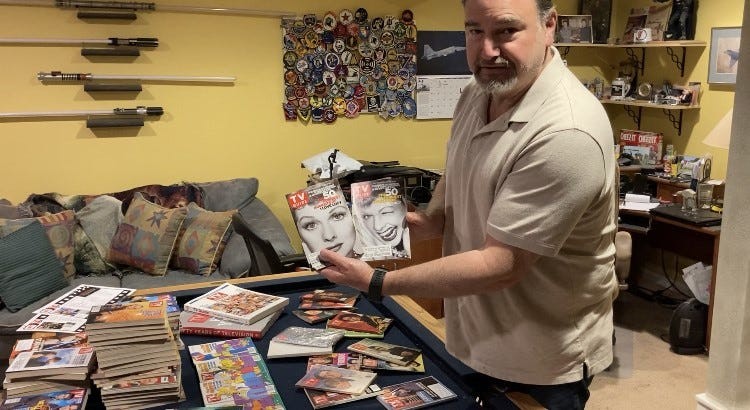To many, old TV Guides are relics of a bygone era, weekly glimpses into the scheduled entertainment. But to collectors, they are historical artifacts, encapsulating moments in television history and pop culture. Gary Frisch, a dedicated collector since 1975, embodies this passion. But what do you do with a massive collection of TV Guides? The question arises: Where To Sell Old Tv Guides?
The Allure of TV Guide Collecting
For Gary Frisch, TV Guide was more than just listings; it was a cultural mirror. “There was something about how it intersected entertainment and culture, and reflected what we liked and how we lived and who we were,” he noted. Each issue captured a snapshot of American society, from significant events like the final episode of M*A*S*H and the wedding of Charles and Diana to groundbreaking miniseries like “Roots.”
Frisch’s dedication led him to amass a vast collection, spanning from 1977 to 2005, the period when TV Guide served as a primary source for navigating the television landscape. The shift to larger format publications marked the end of an era for him.
Challenges in Selling a TV Guide Collection
Frisch’s attempts to sell his collection highlight the challenges faced by TV Guide collectors. TV museums often have sufficient archives. Offers from collectors’ groups might be low, such as around 40 cents per issue for a limited run, making it difficult to part with a comprehensive collection.
His idea to create personalized posters showcasing TV listings from a specific date, like someone’s birthdate, initially failed. But with the rise of the internet, social media, and nostalgia trends, Frisch revisited the concept with “MyTVLife.tv”, suggesting new avenues for monetizing TV Guide collections.
Where to Sell Old TV Guides: Options and Strategies
So, where can you sell old TV Guides? Here’s a breakdown of potential marketplaces and strategies:
-
Online Marketplaces:
- eBay: A popular platform for selling collectibles, eBay can connect you with a broad audience of TV Guide enthusiasts. Highlight key issues, celebrity covers, and historical significance in your listings. Optimize your listings with keywords like “vintage TV Guide,” “collectible TV Guide,” and specific cover stars or events.
- Etsy: If you’re offering creative products based on TV Guides, like Frisch’s personalized posters, Etsy can be a good fit. Focus on the unique value proposition and the nostalgic appeal of your items.
- Amazon: While less common for individual collectibles, Amazon might be an option for selling complete years or specific themed collections of TV Guides.
-
Specialty Collectibles Dealers:
- Research and contact dealers specializing in vintage magazines, pop culture memorabilia, or television history. They can assess the value of your collection and offer a fair price.
-
Auction Houses:
- For particularly rare or valuable TV Guides, consider consigning them to auction houses specializing in collectibles. This can be a good option for high-value items like the first issue featuring Desi Arnaz Jr. and Lucille Ball.
-
Online Collector Communities and Forums:
- Engage with online communities of TV Guide collectors through forums, Facebook groups, and other platforms. These communities can provide valuable insights into current market trends, pricing, and potential buyers.
-
Antique Shops and Flea Markets:
- Consider showcasing your TV Guides at local antique shops or flea markets to reach a local audience of collectors and enthusiasts.
Maximizing Value When Selling TV Guides
Regardless of the chosen platform, the following tips can help maximize the value of your TV Guide collection:
- Condition: Assess the condition of each issue. Factors like tears, stains, fading, and spine damage can affect the price.
- Rarity: Identify rare or highly sought-after issues. The first issue, celebrity covers (especially signed ones), and issues related to significant TV events are usually worth more.
- Completeness: Complete runs of a particular year or series are more valuable than individual issues.
- Presentation: Present your TV Guides in a clean and organized manner. Use protective sleeves or binders to preserve their condition and enhance their appeal.
- Detailed Descriptions: Provide accurate and detailed descriptions of each issue, including its condition, cover star, and any notable content.
- High-Quality Photos: Use clear, well-lit photos to showcase the condition and features of your TV Guides.
- Pricing Research: Research recent sales of similar TV Guides to determine a fair and competitive price.
The Enduring Appeal of TV Guides
Even if selling proves challenging, the intrinsic value of TV Guides remains. As Frisch says, “I still love paging through them, looking at the ads as I create these things… I just enjoy having them.” The joy of owning a tangible piece of television history can be its own reward. The ads themselves are a time capsule, advertising the products and services of a bygone era.
Conclusion
For those wondering where to sell old TV Guides, numerous avenues exist, each with its own potential and challenges. By understanding the market, assessing the value of your collection, and employing effective sales strategies, you can successfully connect with fellow enthusiasts and find a new home for these treasured relics of television history. Whether for profit or the joy of sharing a piece of the past, the journey of selling TV Guides can be a rewarding experience.
